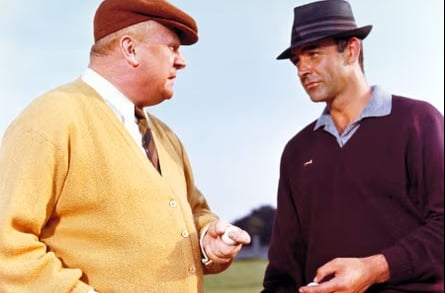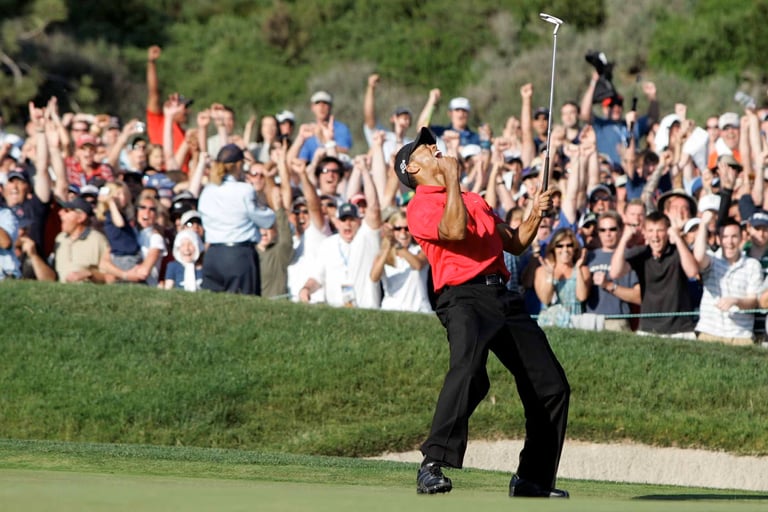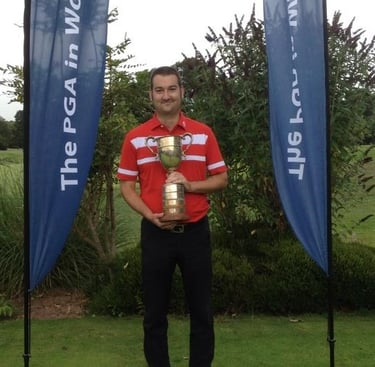James Bond v Tiger Woods: Mental Toughness
Blog post description.
GOLFCINEMA
Chris Mole
5/21/20257 min read


What Are You On About?!
I’ll admit that this link may seem tenuous. One is a fictional spy with a licence to kill, and one is a real golfer with a licence to win. But both taught me how to stay calm and composed under pressure.
We are embarking on a journey today to explore the connection between mental toughness and performance under pressure.
Bond may be fictional, but he is the epitome of mental toughness for me, and Tiger is undoubtedly the best there has ever been at this in the golf world.
As a Golf Professional, I have had to learn how to overcome adversity during rounds of golf to complete my goals.
While it may not be at the same level as Tiger, I have won tournaments at a local level that I wasn’t ready to win before learning some of the things we will discuss here.
What is Mental Toughness, and why is it crucial under pressure?
“Mental toughness is the ability to stay resilient when facing challenges or adversity. It's about maintaining a positive mindset, staying determined, and not giving up in the face of difficulties.” Ryan C. Warner, PHD. (Byrne, 2024)
As Dr Warner states, maintaining a positive mindset is crucial to not giving up and keeping the determination levels high enough to perform at your best. To do this, you must be confident in your abilities to get the job done, and nobody has been more confident than Bond or Woods in this area.
Particularly for Brits like me, it is almost unheard of for someone to be confident in their abilities, but it’s crucial for someone to perform at their best. If you’re a golfer, how often have you told yourself you’ll miss a putt, and then you have missed it?!
Afterwards, you can’t believe that you’ve talked yourself into it. But that is partly because you didn’t persevere through the tough mental times. And this is where our two protagonists come in…
James Bond: Calm in the Chaos
Bond often shows tremendous emotional control under pressure. Although he’s frequently perceived as cold and heartless, his training has taught him how to accomplish the task at hand. His decision-making must be impeccable, considering the many lives, including his own, at stake. In many situations, Bond has been able to rely on his training and confidence in his abilities to extricate himself from danger. The trick was not to make mistakes that brought it on himself.
In both the Fleming novel and the 2006 film adaptation of Casino Royale, Bond experiences extreme conditions when Le Chiffre tortures him. His training had kicked in, and he was able to put up with the excruciating pain as he knew that he had to stall for time in the hopes of a saviour. While that saviour came through an unexpected source, anyone else in his situation would have already been dead.
His lack of fear in this situation shows his mental toughness. Remarkably, he can set aside the danger he is in to focus on getting the job done. Also, doing this with such calmness is equally impressive. Indeed, in the film, he even manages humour while it is happening.
There are many examples of him being able to do this. Where the rational thing to do is to panic, Bond finds a way to remain calm and think logically. This only comes with training and practice. While it may be a fictional character in a death-defying position, rather than a human doing their job, there is a lot we can learn from this for real-life situations, which is shown through Tiger’s exploits.


Tiger Woods: Master of Inner Focus
Woods played in the 2008 US Open, having missed the previous two months due to arthroscopic surgery on his left knee. What we didn’t know until after the tournament was that, during his rehabilitation, he had sustained a double-stress fracture of his left tibia. Woods was clearly in pain throughout the tournament, which made what happened even more remarkable than we could have known at the time.
Woods started solidly through the first three rounds and led by one shot going into the final round. He had won the previous 13 majors that he had led after three rounds, an incredible feat that showed resilience and perseverance of its own. On Sunday 15th June 2008, he would have to show even more.
He double-bogeyed the first hole and bogeyed the second hole to find himself two shots behind Rocco Mediate. As the day progressed, Woods showed increasing pain in his leg and nearly collapsed completely when walking off one tee, having to use his driver as a makeshift walking stick to keep himself upright.
It all came down to the final hole. Woods was one shot behind Mediate and had a 12-foot putt for birdie on the last green to take it to a playoff. Woods studied the putt intently, went through his usual routine, and set the ball on the initial starting line he had chosen. The ball rolled down the green and curled into the hole!
The release of adrenaline and emotion after the putt dropped was astonishing and is one of the most shown reactions in sports history. But it wouldn’t end there. Woods could barely walk by this point, and the US Open was an 18-hole playoff on Monday. He would have to go again the following day.
Woods and Mediate traded birdies and bogeys all day until we reached the 18th hole in the same position as the previous day. Mediate led by one, and Woods needed to find something within himself again. Of course, he did. He birdied the hole again, and it went to a sudden-death playoff. Woods would par the first extra hole, and when Mediate missed his par putt, Woods was Champion.
He wouldn’t play again in 2008 because, after his victory, he had anterior cruciate ligament surgery on his left knee. His ability to switch on and off for each shot and execute his routine was a testament to his unwavering belief in himself and the systems in which he had trained his mind.


The Comparison
Both men were able to train their brains to focus on what they had learned to do in those pressure situations. Their preparation led to confidence in their abilities to complete their jobs.
They knew they could only control their actions in both situations. The opposition couldn’t execute their jobs as well as Bond or Woods could, and therefore, Bond stayed alive, and Woods won the tournament. In both situations, they were up against both mental and physical torture.
The situations that they find themselves in are usually very different. Bond often has to deal with fast-paced action where there is little time to think, so he has to try to be at least one step ahead of the situation.
Tiger is very strategic. He follows a pre-shot routine to avoid feeling pressure. He thinks each individual shot through so that he has a clear plan before he executes it. But both are composed in their environments.
Personal Reflections
Tiger has obviously influenced me personally. He’s the greatest golfer I have seen in my lifetime. The way he meticulously goes through his routine every single time, the time he takes when he has hit a bad shot so that he can allow it to pass and refocus, and his dedication to his practice have all influenced me at times during my playing career.
Because of Tiger, I have a pre-shot routine. But it’s partly because of Bond that I developed my belief in myself to fight through tough patches. Bond became part of my routine the night before tournaments or if I was away for the night during tournaments. I would put on a Bond film and relax, because it would make me feel good to see him come out on top every time, regardless of how hopeless the situation seemed.
This moved into my self-talk.
“What would Tiger Do?”
“How would Bond keep himself motivated when things weren’t going his way?”
It took me a little while to win as a pro, but as soon as I started thinking this way, I went on to win two County Championships, two Union Tankards, and multiple Pro-Ams. My belief in my ability to win, even when I didn’t have my best game, came from knowing that the training and routine would kick in under pressure.
My second County Championship win was in a playoff against someone who had previously beaten me by one or two shots in almost every tournament for the previous few years. It took until the 6th extra hole, and I had to hole a couple of high-pressure putts. However, focusing on the routine took away any thoughts about the end result. I knew the result would follow if I did everything I had trained myself to do.




Takeaways:
As seen from everything discussed in this, there are three action-ready ways to bolster your mental toughness in whatever it is that you want to achieve:
1) Build a routine that you can rely on under pressure
2) Train under pressure, don’t just practice. Imitating real-life situations makes a difference
3) Stay focused on the plan rather than the outcome. The outcome will follow if you put the steps in place.
